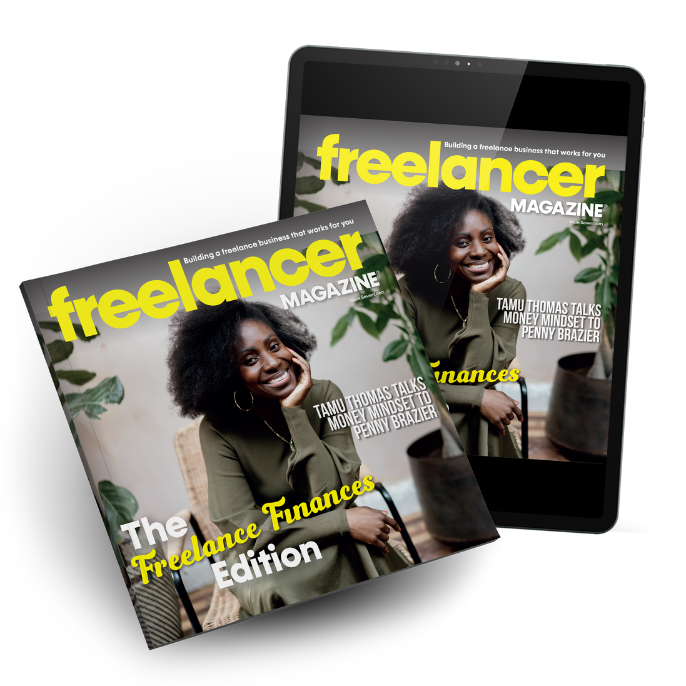Have you ever had a client with whom you had to constantly follow up to get your old invoices paid? Or a time when had to make countless revisions and the project seemed endless?
These are classic instances of ignoring client red flags.
You need to know how to spot a good client to create a freelance business you love to work on. You can start by listing down some non-negotiables for client relationships to get clarity on what makes a great client for your business.
Having a list of non-negotiables lets you say “no” to clients that are a bad fit. While it might seem scary at first, you’re only opening room for clients that would be a dream to work with. After all, you chose freelancing to work on your terms, the people you want to work with, and the projects you want to work on.
Here are 15 red and green flags each that’ll give you a starting point for creating your checklist.
Red Flags – A Bad Egg
-
They lack clarity: “I’ll know when I see it” – clients who are unable to articulate their project goals, expectations, and requirements only lead to miscommunication and misunderstandings throughout the collaboration. You’ll end up having constant revisions and dissatisfaction for both parties.
They treat you like an employee: If you have a client who treats you like an employee from the start, it’s only going to get worse as time goes on. Lizzie Davey, a freelance writer for SaaS brands, puts this as one of the top red flags in a client:
“It usually begins with them dictating the rates, the scope, and the timelines without asking for your input. I’ve found that clients like this don’t understand the value of working with a freelancer and will often change the goalposts and ask for very last-minute requests. What initially starts out as a client who seemingly knows what they want (which is great!) can quickly turn into a nightmare of endless edits and a monopoly on your time.”
-
Constant scope creep: If you started working as a social media posts designer and eventually started designing infographics for blogs too (without any increased payment), this is for you.
Scope creep doesn’t happen overnight, but you’ll be able to spot the signs early on. Phrases like “this will only take you 15 minutes to do” or “this won’t take much time” when requesting extra work early on in the relationship are good indicators of what’s about to come. Consistently expanding the scope of work without adjusting the budget or timeline will strain your resources, leading to compromised work quality and potential financial losses.
To avoid this, mention the scope of the work clearly in your contract.
-
Poor communication: If you’re receiving consistently delayed responses to emails or if it takes you several weeks to get approval on something, it’ll unnecessarily stretch the project timeline. What’s worse, you’ll have difficulty taking on new clients or meeting existing deadlines.
Make sure you put the project timeline in your contract and establish a clear approval cycle as soon as you start with a new client.
-
They don’t respect your boundaries: If a client expects you to be available right away, it’s never a good sign. Kaleigh Moore, an acclaimed freelance writer says,
“You’re not an employee, so it’s not their place to tell you when and how quickly you need to reply to communications. I think a good rule of thumb is within 24 hours on business days; you absolutely don’t need to be fielding calls at 6 pm on a Tuesday night. Boundaries are key for both parties.”
Frequent late payments: Consistent late payments create unnecessary financial stress, reducing your ability to focus on providing the best work possible. Keep clear payment terms in your contract but if the payments are never on time, it might be time to let go of a client.
Disrespectful behaviour: Clients who show rude, condescending, or disrespectful behaviour towards you or your colleagues should raise serious concerns about the overall working relationship.
Lack of professionalism: Constant rescheduling, frequent cancellations, or abrupt changes in project requirements disrupt your workflow and decrease productivity. This inconsistency and lack of professionalism can create frustration and make it difficult for you to meet deadlines and deliver quality work.
Poor track record: Clients with a history of negative reviews, disputes, or unethical business practices should be approached with caution. Research a client’s brand before you even get on a discovery call to avoid potential conflicts.
Incompatibility with values: Clients whose business practices, values, or ethical standards clash with yours might lead to conflicts and compromise your professional integrity. It’s important to align yourself with clients who share similar values and principles for a smooth working relationship.
Micromanagement: Clients who constantly scrutinise every aspect of your work undermine your expertise and hinder your ability to deliver quality results. Micromanagement leads to not only increased stress and limited creative freedom but also a strained client-freelancer relationship.
Unresponsive decision-making: Clients who struggle to make timely decisions or constantly change their minds cause project delays and disrupt your workflow. Ineffective decision-making results in a lack of progress and increased revisions.
Constant emergency mode: Clients who operate in a perpetual state of crisis, always demanding urgent attention and immediate responses, can create a stressful work environment. Constantly being in emergency mode doesn’t let you plan and execute projects effectively, leading to burnout and subpar results.
Poor organisation: Clients with disorganised communication, missing files, or inconsistent project management only lead to confusion, delays, and a lack of productivity. Poor organisation disrupts workflow and makes it difficult to stay on track and meet project deadlines.
Green Flags – The Dream Client
-
Clear Project Goals: This type of client knows what their expectations and desired outcomes are. They’re clear on the KPIs and the timeline and have a clear vision at the core of the project. You can usually sense this in your earliest calls with the client as the client provides a clear direction.
They have systems and processes in place: When you onboard a client and the first thing that they do is share an Airtable (or any other project management) board? That’s how you know it’s going to be a smooth experience. Stephanie Trovato, a freelance B2B writer, says,
“I’m a process person. Processes keep things smooth, streamlined, and functioning properly. And while some companies may not have every process nailed down, there should always be some kind of workflow outlined, otherwise, how does anyone know what they’re doing? I’ve found that when companies lack any kind of process for freelancers or creating content in general, it leads to miscommunication issues, scope creep, and frustration on both sides.”
You can ask these questions in the discovery call itself: How do they usually work with freelancers? What’s their strategy like?
They have a budget: These clients understand the value of your services and provide a fair and realistic budget indicating respect for your expertise. There’s no haggling over rates and you save both your and the client’s time. David Hartshorne, a freelance B2B writer with several years of experience shares how he goes about the initial client interactions:
“When taking on a new freelance client, the first thing I establish is if they’re comfortable with my proposed rate. Once that’s cleared, I want to understand more about the project and liaise with the point of contact. Sometimes the client has a process that I need to fit in with. Sometimes I need to share my working process because they’ve never worked with freelancers. Either way, these are the ground rules that can make or break a working relationship.”
Professionalism and respectful communication: This might seem obvious but you’d be surprised at the horror stories some freelancers have. Being responsive to communication, showing up to meetings on time, and respectful communication is key to a productive client relationship.
Compatible working style: Clients who have a similar working style, processes, or approach to projects can be a breeze to work with. The process is smoother for both you and the client, creating the grounds for a great relationship.
Previous positive feedback: Clients who have a history of positive feedback, testimonials, or recommendations from previous freelancers reinforce their credibility and reliability. Such clients are more likely to appreciate and value your work, creating a positive and supportive working dynamic.
Long-term partnership potential: This varies from case to case. Generally speaking, clients who express a desire for a long-term collaboration or have a track record of establishing lasting relationships with freelancers are often more invested in fostering successful partnerships. That gives you stability, consistent work, and growth opportunities.
But you might also come across clients who might try to lower your rates just because of the potential of a long-term relationship. Keep in mind the other red flags when you come across something similar.
Collaborative approach: Clients who value your input, involve you in important decisions, and include you in the creative process foster a sense of partnership. This collaborative approach ensures that your expertise is recognised and your contributions are valued, resulting in a more fulfilling and satisfying working relationship.
Realistic deadlines: Clients who set reasonable deadlines that allow for quality work and account for potential challenges show an understanding of the creative process.
Organisation and preparedness: Clients who provide you with project materials, files, and resources in a timely manner will never be a letdown (usually). For example, as soon as you onboard them, they share the brief you need to get started and you aren’t constantly following up for a brand or style guideline.
They pay you on time: The best clients consistently make payments on time and adhere to agreed-upon terms. Financial reliability builds trust and allows you to focus on delivering your best work without concerns about payment delays.
Supportive of creativity: “I trust you with this” – clients who encourage creative freedom, value innovative ideas, and support experimentation provide an environment where your creativity can thrive. Such clients allow you to bring your unique perspective and creative solutions to the table, leading to more exciting and fulfilling projects.
They are VC-backed: With a VC-backed company, you know they’re interested in investing the resources to market better. There are also high chances of them having a suitable budget for your work and paying on time.
They don’t ask you for free work (or consultations): If a prospect asks you for a “test copy”, that doesn’t directly imply that they’re not a good fit. The problem is when they expect you to hours on something unpaid. But if a client gives you a paid test piece, it’s a great indicator of a healthy relationship in the future.
They appreciate and value your work: If a client agrees to pay your fees, appreciates a job well done, and values you as a freelancer, that’s a dream client to work with.
Create Your Own Checklist
Remember, while these red flags and green flags can serve as a guide, you need to tailor your checklist to your specific industry and personal preferences. What’s important is, you have a system in place to identify when a client is a good fit for you.
Take on points from the list to include in your contract and make sure you get the contract signed. If a prospect refuses to sign a contract, that’s another red flag.
Written by Megha Seth






